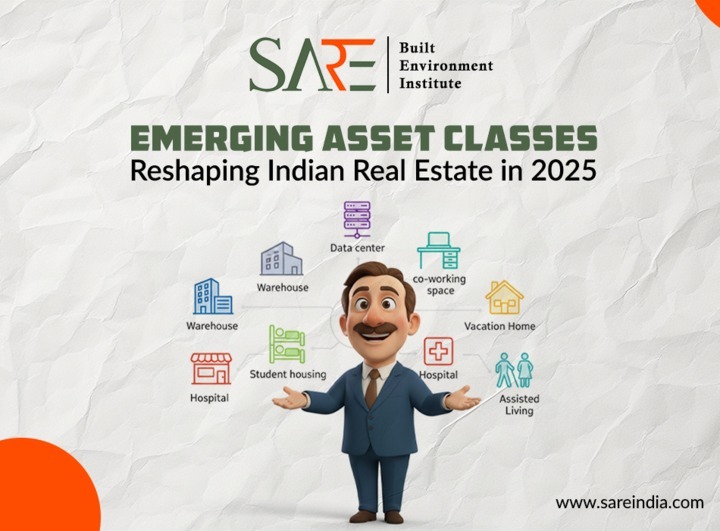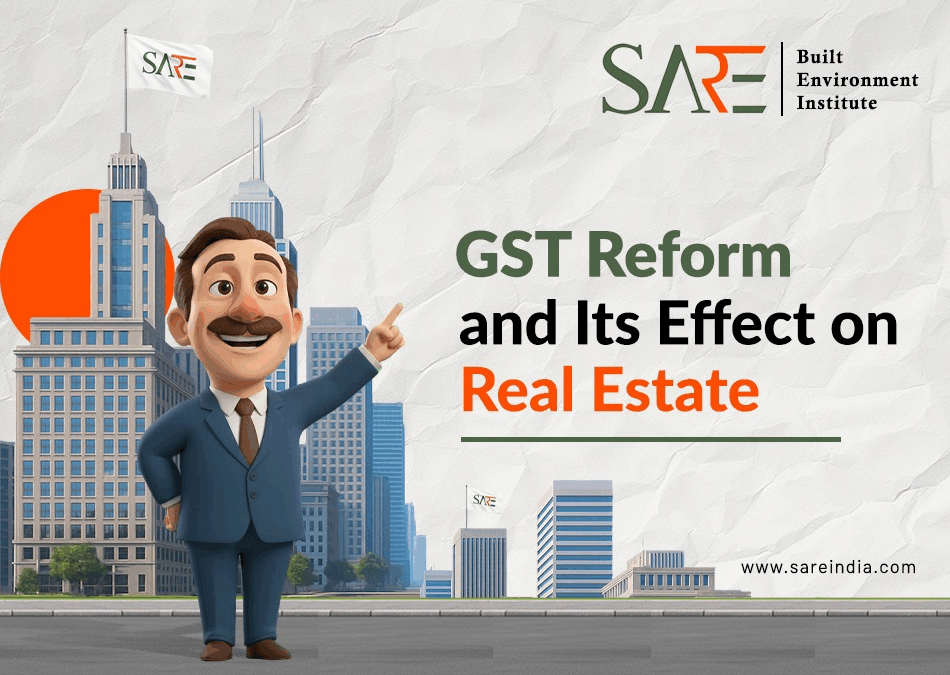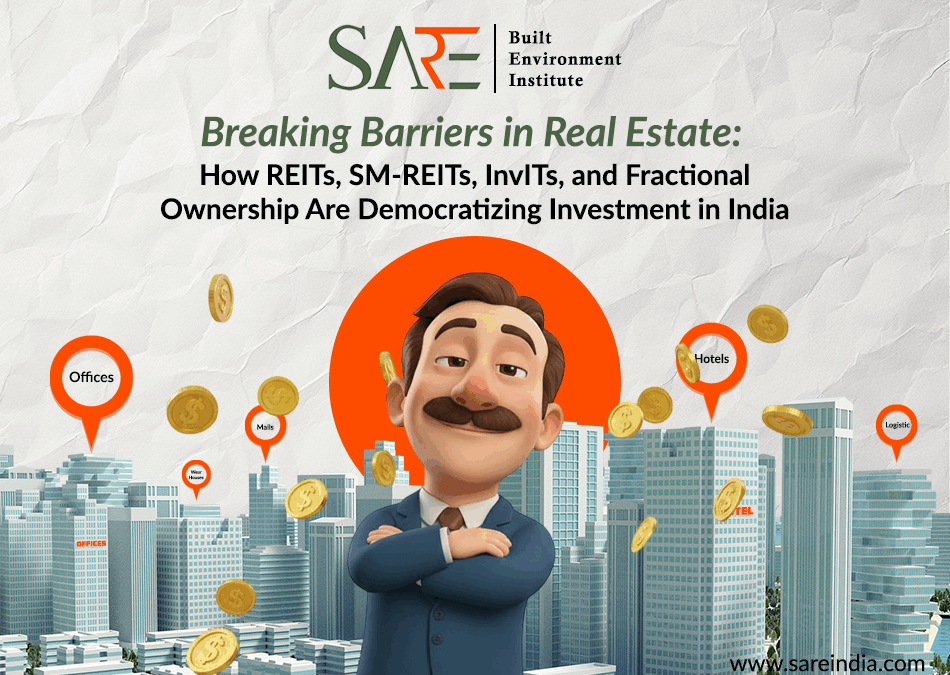As a result, investors and developers are focusing on asset classes that not only offer attractive financial returns but also unique opportunities for diversification, innovation, and social impact. These asset classes are the supporting pillars of India’s booming real estate industry.
Classification of Asset Classes
| Category | Examples |
|---|---|
| Commercial | Data Centers, Co-Working Spaces, Global Capability Centres (GCCs), Parking Spaces |
| Retail/Logistics | Warehousing, Retail-driven logistics hubs, Dark Stores, Multi-modal Logistics Parks |
| Residential | Affordable Housing, Luxury Real Estate, Co-Living |
Data Centers (Commercial)
Data centers are physical facilities designed to store, manage, and operate digital infrastructure. With the rapid adoption of cloud, AI, and 5G, India is emerging as a global hub for data centers global hub for data centers.
- India’s data center industry is growing at a CAGR of 15–20% (2024–29) (JLL).
- Current capacity of ~1,400 MW in 2024 (where MW-Megawatt quantifies the maximum power available for all servers and supporting systems in a data center) is expected to double to ~3,000 MW by 2028(JLL).
- By 2027, the colocation market may reach 23 million sq. ft. (CBRE).; in these shared facilities, businesses lease space to house their IT equipment in professionally managed environments.
- Growth is strongly fueled by Global Capability Centres (GCCs) of multinationals, cloud adoption, and supportive government policies.
While Tier-1 cities face land shortages, Tier-2 and Tier-3 cities are emerging as data center hubs due to the availability of cheaper land and power.
Data centers offer long-term leases, stable returns (12–16%) (Colliers), and low-to-medium risk , making them one of the most promising commercial real estate assets.
Co-Working Spaces (Commercial)
The hybrid work revolution has fueled demand for flexible office spaces. Startups, freelancers, and even large corporations are embracing co-working setups to reduce fixed costs.
- Growth is expanding beyond metros into Tier-2 and Tier-3 cities, where office infrastructure is not upto the mark.
- Co-working offers flexibility, adaptability, and community-driven models for businesses.
Investors see strong demand in the 5–7 year horizon, though risks are higher due to fluctuating occupancy rates.
Warehousing (Retail/Logistics)
India’s warehousing and logistics sector is booming, driven by e-commerce growth and government initiatives.
- By 2024, India’s warehousing footprint reached 533 million sq. ft., including ~100 million sq. ft. in Tier-2/3 cities (JLL).
- Leasing volumes rose by 50% YoY in Q1 2025, totaling 16.7 million sq. ft. (Construction World, India Seatrade News).
Warehousing offers double-digit returns with low-to-medium risk, especially in e-commerce-linked hubs.
Co-Living Spaces (Residential)
Co-living is becoming popular among millennials, students, and young professionals.
- The market is projected to expand from 300,000 beds in 2025 to 1 million beds by 2030 (Colliers).
- Market penetration will cross 10% by 2030, compared to ~5% today.
- Co-living is 20–35% cheaper than renting a 1BHK apartment, making it attractive for affordability-driven demand. (Economic Times)
Recent investments, such as Bain Capital and Sattva’s $100 million co-living platform (Business Standard), highlight strong investor confidence. Industry analysts estimate co-living yields in the 10–12% range, making it an attractive segment.
Luxury Real Estate (Residential)
India’s GDP is projected to grow to 23 – 35 Tr. USD by 2047, giving rise to many billionaires & HNIs, who will look for luxury housing & this segment is gaining momentum.
- Analysts project property prices across leading Indian cities will rise ~6.5% in 2025 (Reuters).
- Demand has shifted to larger homes with wellness features, branded residences, and smart-home integrations.
- Luxury real estate also includes High-End Apartments, Country Homes, Farmhouses & Vacation Homes too.
Luxury housing carries medium risk, but remains attractive for affluent buyers and long-term appreciation.
Highway Stops (Commercial / Retail)
New highways and road infrastructure are expanding rapidly, and highway-side retail shops and commercial plazas are emerging as lucrative opportunities. High footfall from travelers and commuters translates to strong rental potential, making these a unique but promising retail/infra asset.
Schools & Hospitals (Social Infra / Commercial)
Schools and hospitals are considered essential services, making them stable real estate investments. With long-term leases and steady demand, they provide resilience against market fluctuations. Investors are increasingly viewing them as reliable, defensive assets in their portfolio mix.
Student Housing (Residential)
The shortage of affordable, quality housing near universities has made student housing a strong growth segment. With high occupancy rates and predictable rental income, this asset class is drawing institutional investors. Demand is especially strong in education hubs like Pune, Bangalore, and Delhi NCR.
Assisted Living / Senior Housing (Residential / Social Infra)
With India’s rapidly ageing population, demand for assisted living and old age homes is rising. These projects focus on healthcare, safety, and community-driven living. They are socially impactful, relatively resilient to market cycles, and offer steady long-term returns as demographic shifts accelerate.
Affordable Housing (Residential)
Affordable housing continues to be one of the most successful projects of Indian real estate. Supported by government schemes, subsidies, and incentives, demand is rising among middle-income families, first-time buyers, and urban migrants.
- According to a 2025 consumer survey, 8 out of 10 homebuyers are concerned about rising prices, with properties up by ~50% compared to 2023 (The Economic Times).
- Scarcity of land in city limits is pushing affordable housing projects to peri-urban areas and smaller towns. While this helps meet demand, it often results in weaker infrastructure and connectivity challenges.
Despite these challenges, affordable housing remains a socially vital and financially stable segment, supported by long-term demand.
Risk–Return Profiles
| Asset Class | Potential Return | Risk Level | Investment Horizon |
|---|---|---|---|
| Data Centers | 12–16% | Low-Medium | Long-term (10–15 yrs) |
| Co-Working Spaces | 10–12% | Medium-High | Mid-term (5–7 yrs) |
| Warehousing | 10–13% | Low-Medium | Mid to Long-term |
| Co-Living Spaces | 10-12% | Medium | Mid-term(5-7 yrs) |
| Luxury Housing | 8–9% | Medium | Mid to Long-term |
| Highway Stops | 8–15% | Medium | Mid-term |
| Schools & Hospitals | 7-9% | Low | Long-term |
| Student Housing | 8-12% | Low-Medium | Mid-term |
| Senior Living | 7-9% | Low-Medium | Long-term |
| Affordable Housing | 6-9% | Medium | Mid to Long-term |
Despite these challenges, affordable housing remains a socially vital and financially stable segment, supported by long-term demand.
Emerging & Alternative Classes
Beyond the main categories, new forms such as parking infrastructure, multi-modal logistics parks, and industrial land are taking center stage. In tier-1 and 2 cities, parking spaces have become a basic requirement due to increasing vehicle ownership and the reduction of vacant spaces.
Similarly, multi-modal logistics parks are becoming crucial for integrating warehousing, transportation, and supply chain facilities under one roof to support India’s booming e-commerce and manufacturing sectors. These emerging classes further diversify real estate portfolios, offering opportunities well beyond traditional residential models.
Why Investors Are Diversifying Beyond Traditional Assets
Emerging asset classes allow investors and developers to diversify beyond traditional residential and commercial segments. These offer diversification as well as give better returns. Private equity and institutional players are pouring capital into data centers, co-living, warehousing, and affordable housing, all offering stronger yields, long-term leases, and scalable growth. Sustainability, technology integration (IoT, automation), and inclusive models are driving the industry forward.
Innovation, Sustainability & Inclusivity: The Future of Indian Real Estate
The coming years will see Indian real estate driven by forward-thinking innovation, sustainable practices, and inclusive growth.
- Technology-driven developments like data centers, smart co-living, and robotized warehouses will dominate.
- The sector must strike a balance, providing affordable housing for the masses alongside premium living for HNIs.
- Warehousing and data centers are poised to be key growth engines, backed by policy, demand, and infrastructure investment.
India’s real estate market is transforming from the one-dimensional world of housing and offices into a multi-dimensional ecosystem made by digital infrastructure, logistics, flexible living, and socio-economic diversity.
In the years ahead, this sector will not only remain a lucrative avenue for investors seeking strong returns but also emerge as a high-potential career field for young professionals. Whether you’re an aspiring developer, broker, investor, or simply someone curious about this dynamic industry, understanding these emerging asset classes is key to unlocking the next wave of opportunities.
At SARE Built Environment Institute, our upcoming training programs are designed to give you both foundational knowledge and advanced expertise in real estate operations, compliance, and new-age property models. From traditional property listing to emerging asset classes in real estate space, our curriculum equips you with the concepts and insights most valued by today’s employers.
Whether you’re just starting out or looking to sharpen your skills, we provide the tools, frameworks, and confidence to succeed. You’ll learn how to navigate India’s evolving property market, manage complex transactions, and make a meaningful impact in diverse real estate roles.
👉 Follow us to stay updated on industry trends and take the first step toward becoming a job-ready professional in the fast-growing Indian real estate sector.













0 Comments